Azerbaijanis have a very sweet-tooth and rarely need a reason for indulging their passion, but the Novruz spring holiday provides the perfect excuse. Many of us simply cannot resist the temptation of the traditional pastries and sweets baked to mark Novruz. Our bodies are a little weaker after winter and short of vitamins and other nutrients. There is a tradition of putting seven dishes (Yeddilavin) on the Novruz table. Almost every family is sure to roast wheat with nuts, raisins and dried fruit (mulberry, apricot, persimmon etc.), dye eggs and bake traditional pastries such as shekerbura (sweet nut pies), baklava, shekerchorek (sugar bread biscuits) and shorgogal (savoury pastries with turmeric and fennel). These pastries are prepared differently, in the different regions of Azerbaijan.
Sheki is known in particular for its distinctive baklava and fasali. The people of Baku prefer flour-based pastries, including shekerbura, baklava, mutakka (pastry twists) and shorgogal. Those living in and around Ganja cook Ganja baklava and shekerchorek, while the people of Quba, Nakhchivan, Zaqatala, Lenkeran, Shamakha, Karabakh and other regions of Azerbaijan all have their favourite Novruz pastries. Overall, there are more than 100 types of pastries and sweets in Azerbaijan.
Shekerbura – Sweet Nut Pies
Dough: 2 kg top-grade flour, 0.5 kg clarified butter, 0.7 litres milk, 5 yolks, 50 gm yeast, half teaspoon salt.
Filling: 1 kg shelled almonds or hazelnuts, 1 kg granulated sugar, half a teaspoon ground cardamom, half a glass rosewater.
To prepare the filling, grind the almonds or hazelnuts finely and mix with an equal weight of sugar. Then add the cardamom for fragrance. Finally, add the rosewater and stir the mixture again. If you have no rosewater, pour half a glass of hot water over the cardamom, leave it for up to 2 hours and add to the mixture. The resulting filling is moist, which makes the shekerbura even better.
Sieve the flour into a large bowl. Add the butter and rub into the flour until no large lumps are left. Add the salt and yeast. Make a hole in the middle of the mixture and add the eggs and lukewarm milk (heated to 30-35°C). Fold in and knead into a smooth dough.
Allow the dough to rise for 1-1.5 hours and then divide it into 30 g pieces. Roll it out to make small circles 2-3 mm thick. Place a tablespoon of filling onto each circle, fold into the form of a crescent and crimp the edges into a spiral pattern. Various designs are made on the surface of the shekerbura using special tweezers or tongs known as maqqash. Leave the decorated shekerbura to stand for at least an hour and then put in the oven and bake at 160-180o for 25-30 minutes.
When the shekerbura have cooled to room temperature, place them in a tin or other container where they can be kept for up to 25 days.
To cook just a few shekerbura, use the following measurements.
1.5 glasses top-grade flour, 3-4 tablespoons clarified butter, third of a glass whole milk, 1 egg, 6 gm yeast, 1 glass shelled almonds or hazelnuts, 1 glass granulated sugar, pinch of cardamom, pinch of salt.
Baku baklava
1.5 glasses top-grade flour, 3-4 tablespoons clarified butter, third of a glass whole milk, 1 egg, 4 g yeast, 1 glass shelled almonds or hazelnuts, 1 glass granulated sugar, a few threads of saffron, 3 cardamom pods, 1 tablespoon honey, 8-10 shelled pistachios.
Baklava is cooked in round or rectangular baking tins deep enough to hold the layers of pastry. A larger amount of baklava can be cooked using the measurements given in the shekerbura recipe. Use half a kg clarified butter, 2 egg yolks, several threads of saffron, 150 g honey, 100 g hazelnuts or pistachios (to decorate the baklava) for each baking sheet.
The dough and the filling are the same as for shekerbura. Depending on the size of the baking sheet, prepare 8 to 10 balls of dough. Two of them should be larger. Roll one of the 2 larger balls of dough to 2 mm thickness. Place the layer of pastry into the well buttered baking tin, making sure that it covers the base completely. Brush the pastry with melted butter, then spread the filling over the dough to 3-4 mm thickness. Roll out a smaller ball of dough until the pastry is 0.5 mm thick. Place it on top of the filling on the first layer. Spread the pastry with melted butter and filling, then repeat the process until you have 8-10 layers of pastry and filling. Take the larger ball of dough and roll it out until it is 2 mm thick. Place this thicker layer on top of the baklava in the pan and press the edges down to prevent the filling from leaking out. Leave it to stand for a while, then cut the baklava in the tin into 10x4 cm diamond-shapes. Brush the surface with egg yolk mixed with saffron, and place half a hazelnut or pistachio on each baklava. Cook for 35-50 minutes at 180-200o. Fifteen minutes before the end of cooking, spread honey over the surface of the baklava. If using sugar instead of honey, melt the sugar in water, bring to the boil, simmer, remove the froth and pour the boiling liquid over the baklava. After cooking, leave the baklava to cool on the baking sheet, then cut with a thick knife and place on a plate.
Shekerchorek – Sugar-bread biscuits
3 glasses top-grade flour, 1 glass clarified butter, 1.5 glasses granulated sugar, 1 egg, a few drops of vanilla essence.
Cream the clarified butter and sugar. Separate the egg yolk from the white and gradually add the white to the butter and sugar, beating for at least 10 minutes after each addition. Overall the mixture needs to be beaten for 25-30 minutes or the finished biscuits will be heavy. Take 60-75-gm pieces of dough, roll them out and place them on a baking sheet covered with baking paper. Brush a couple of drops of egg yolk onto the centre of each biscuit. Bake for 25-30 minutes at 175-180o. When the shekerchorek are cool, sprinkle fine sugar over them.
Chudu – Meat pasties
300 g minced lamb, 1.5 glasses clarified butter, 1 egg, 2.5 glasses top-grade flour, 8 gm yeast, 2 medium-size onions, 1 tablespoon sugar, 1 teaspoon sumac, half teaspoon cinnamon, pepper and salt.
Mix the meat and onions together, add salt, pepper, cinnamon and sumac, and fry the mixture. Sieve the flour into a large bowl or onto a work surface, make a hole in the middle and add the eggs, butter and yeast. Fold into the mixture then knead into a smooth dough. Divide the dough into small balls and roll out to 1 mm thickness. Brush the layer of dough with melted butter, then place another layer on top, brush with butter and add another layer. Continue until you have put five or six layers together, then cut the layers of dough into 7x8-cm pieces. Fill each piece with the previously prepared meat mixture, fold up like a pasty and seal the edges. Deep fry in hot oil or bake in a medium-hot oven for 20 to 25 minutes. Dip the warm chudu in sumac. When cool, sprinkle with sugar. This gives the chudu their distinctive flavour of sweet and sour.
Shamakhi mutakka – Shamakhi jam-filled pastry twists
Dough: 3 glasses top-grade flour, 2 eggs, 100 g butter, 1 glass milk, 2 tablespoons sugar, 10 g yeast, half teaspoon salt.
Filling: Half glass apricot puree, half glass sugar, 2-3 drops of vanilla essence, 2 tablespoons of icing sugar for dusting.
Pour the hot milk over the yeast, add the egg, salt and sugar powder and mix. Add the flour and knead the dough for 15 minutes. Leave the dough to stand in a warm place for 1.5 hours. Meanwhile, mix the apricot puree with the sugar and fry until it becomes a thick mass. Then let it cool. Roll the dough to 4-5 mm thickness, spread the butter over it and cut it into small triangles. Place half a teaspoon of filling onto each piece and roll into a tube, sealing the ends. Bake for 10-15 minutes at 190-200o. When they are cool, sprinkle icing sugar over the muttaka.
Nakhchivan choche – Nakhchivan walnut and onion pies
Dough: 700 ml milk, 750 g butter or margarine, 5 eggs, 50 g yeast, 2 kg top grade flour, half teaspoon salt.
Filling: 1 kg shelled walnuts, 10 medium-size onions, 250 g butter, 2 glasses flour, turmeric, coriander, salt and pepper, 2 eggs for glazing.
Heat the milk to 35-40o, pour over the yeast and mix with the eggs, butter or margarine, salt and flour. Let the dough rise in a warm place (25o) for 1.5-2 hours.
Meanwhile, mix 2 glasses of sieved flour with a little water. Fry the resulting paste and sliced onion in cooking oil, add salt, mix with the spices (turmeric, pepper and ground coriander seeds) and ground walnuts. Divide the dough into 35-40-g balls, roll them out and place a tablespoon of filling onto each piece of dough. Bring the edges together and scrimp into a spiral pattern like shekerbura. Place them on a baking sheet, allow to stand for 30-35 minutes, brush with beaten egg yolk and bake for 30-35 minutes at 210-220o. Serve with tea.
Gulabli qovut – Rosewater wheat
Half glass wheat, 7-8 ground walnuts, 3 teaspoons sugar, a few threads of saffron, half a teaspoon of cinnamon, half a teaspoon of coriander seeds, 1 tablespoon rosewater.
Put a few threads of saffron in a cup and add hot water. Leave to infuse. Roast the wheat grains by cooking for 5 to 8 minutes in an ungreased frying pan, stirring or shaking the pan continuously to prevent the wheat burning. Remove from the heat before the wheat gets too dark. Make a syrup from 50% sugar and water, allow it to cool and add saffron infusion and rosewater. Grind the roasted wheat, walnuts and coriander seeds in a nut or coffee grinder. Mix this with the syrup, cinnamon and saffron infusion, stirring well. Shape the mixture into circles and make a criss-cross pattern on top with a fork. Leave to set.
Qozlu borucuq – Walnut rolls
2.5 glasses top-grade flour, 200 g sour cream, half glass clarified butter, 1 glass shelled walnuts, 1 glass sugar, 2 tablespoons honey, 1 teaspoon cinnamon, 1 egg.
Mix the butter and sour cream, then add the sieved flour to make dough and knead it. To prepare the filling, lightly roast the walnuts, grind them and mix them well with the sugar, honey and spices. Divide the dough into 40-g pieces, roll into strips with one end wider than the other. Place 30 g filling onto each piece and roll it up. Brush egg yolk over each piece. Bake for 20-30 minutes at 180-200o. The pastry dough may also be made with yeast.
About the author: Prof. Dr Ahmad-Jabir Ahmadov is head of the Department for the Study of Food Products at the Azerbaijan State University of Economics. He is the author of more than 300 research works on Azerbaijani cuisine, including more than 50 books. He has created a range of pastries.
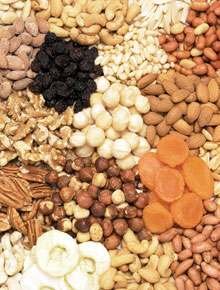
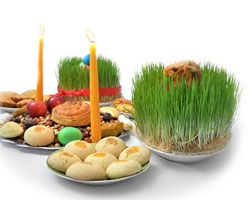

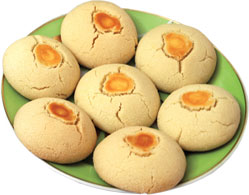
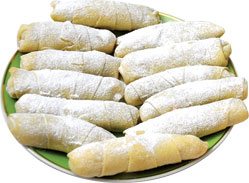

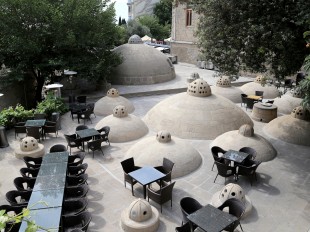
.jpg)